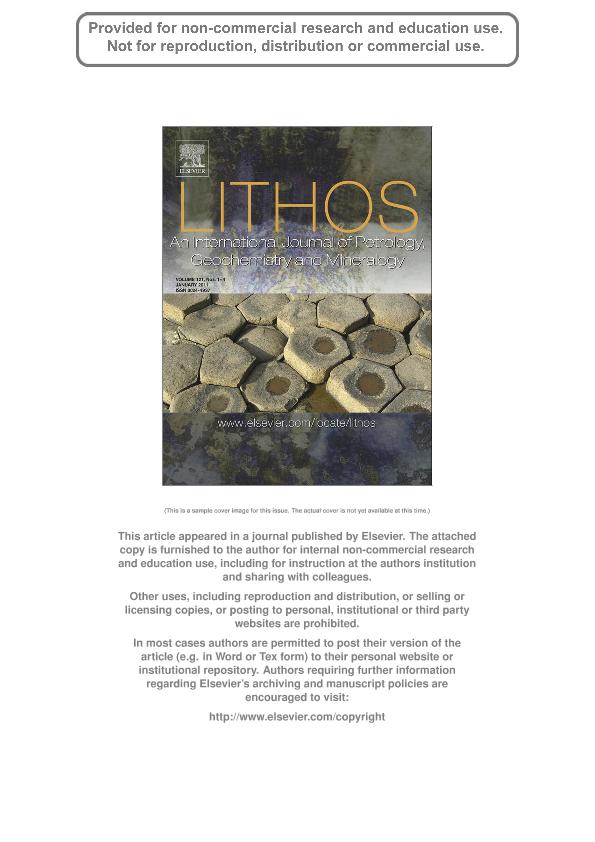Mostrar el registro sencillo del ítem
dc.contributor.author
Caffe, Pablo Jorge

dc.contributor.author
Trumbull, Robert

dc.contributor.author
Siebel, Wolfgang
dc.date.available
2023-03-09T15:24:30Z
dc.date.issued
2012-03
dc.identifier.citation
Caffe, Pablo Jorge; Trumbull, Robert; Siebel, Wolfgang; Petrology of the Coyaguayma ignimbrite, northern Puna of Argentina: Origin and evolution of a peraluminous high-SiO 2 rhyolite magma; Elsevier Science; Lithos; 134-135; 3-2012; 179-200
dc.identifier.issn
0024-4937
dc.identifier.uri
http://hdl.handle.net/11336/190082
dc.description.abstract
The Coyaguayma ignimbrite is a strongly peraluminous (SP), sillimanite, garnet-bearing silicic rhyolite which erupted in the northern Puna segment of the central Andean plateau in the Upper Miocene (~11Ma), a period that was characterized by the eruption of voluminous (100s to 1000s km 3) dacitic ignimbrites of high-K calc-alkaline affinity. In this region, the SP magmatic rocks are both rare and small, but their importance is potentially much greater as rocks of this type are usually interpreted as products of crustal melting and therefore useful for addressing mantle addition vs crustal recycling in the central Andes.The phenocryst assemblage of the Coyaguayma ignimbrite comprises plagioclase (An26-18), quartz, Ba-rich and Ba-poor sanidine, minor Al-rich ferromagnesian minerals (Al T- and Al VI-rich biotite, almandine-spessartine garnet) and sillimanite, as well as accessory zircon and monazite. Textural relations suggest that the accessory and ferromagnesian phases crystallized before quartz and feldspars. Mineral equilibria suggest that crystallization of the rhyolite magma began at ~5kbar and 800°C, and continued almost isobarically to 720°C, causing the residual liquid to increase H 2O contents from ~4-5% to ~7.5% before eruption.Most major features (e.g., high SiO 2, A/CNK >1.3, low CaO, MgO, TiO 2 and FeO) and trace element patterns (low Ba, Sr, Th, LREE and Eu/Eu*; high Rb, U, Y and Nb), along with the thermobarometric constraints on magmatic P, T and water contents are consistent with an origin by mica dehydration melting of metapelitic sources (e.g., typical biotite-muscovite gneisses from the outcropping S Puna basement). However, the relatively low initial 87Sr/ 86Sr (~0.7125), and high 143Nd/ 144Nd (~0.512200) ratios invalidate a pure crustal origin. Instead, we propose contamination of calc-alkaline dacitic magmas similar to typical Puna ignimbrites by metapelite at mid-crustal settings (≥18km depth). Geochemical modeling that satisfies the chemical and isotopic data suggests mixing of 70% dacite and ~30% of metapelite partial melts, followed by extensive (70%) fractionation of plagioclase, K-feldspar, quartz and biotite, with minor magnetite and apatite from the hybrid magma. Sillimanite in the Coyaguayma rhyolite is interpreted as a restite mineral or a product of incongruent melting of the metapelite, which was preserved intact in the hybrid melt due to local equilibrium.This petrogenetic model explains most characteristics of crystal-poor SP rhyolites from the Puna plateau (e.g., Tocomar, Ramadas rhyolites) and it may be more generally applicable to occurrences of SP magmas in Andean-type continental arcs dominated by calc-alkaline magmatism.
dc.format
application/pdf
dc.language.iso
eng
dc.publisher
Elsevier Science

dc.rights
info:eu-repo/semantics/openAccess
dc.rights.uri
https://creativecommons.org/licenses/by-nc-sa/2.5/ar/
dc.subject
ASSIMILATION
dc.subject
CENTRAL ANDEAN PLATEAU
dc.subject
FRACTIONATION
dc.subject
NORTHERN PUNA
dc.subject
SIO 2-RICH RHYOLITE
dc.subject
STRONGLY PERALUMINOUS
dc.subject.classification
Vulcanología

dc.subject.classification
Ciencias de la Tierra y relacionadas con el Medio Ambiente

dc.subject.classification
CIENCIAS NATURALES Y EXACTAS

dc.title
Petrology of the Coyaguayma ignimbrite, northern Puna of Argentina: Origin and evolution of a peraluminous high-SiO 2 rhyolite magma
dc.type
info:eu-repo/semantics/article
dc.type
info:ar-repo/semantics/artículo
dc.type
info:eu-repo/semantics/publishedVersion
dc.date.updated
2023-03-09T14:38:40Z
dc.journal.volume
134-135
dc.journal.pagination
179-200
dc.journal.pais
Países Bajos

dc.journal.ciudad
Amsterdam
dc.description.fil
Fil: Caffe, Pablo Jorge. Universidad Nacional de Jujuy; Argentina. Consejo Nacional de Investigaciones Científicas y Técnicas; Argentina
dc.description.fil
Fil: Trumbull, Robert. German Research Centre for Geosciences; Alemania
dc.description.fil
Fil: Siebel, Wolfgang. Eberhard Karls Universität Tübingen; Alemania
dc.journal.title
Lithos

dc.relation.alternativeid
info:eu-repo/semantics/altIdentifier/url/https://www.sciencedirect.com/science/article/pii/S0024493711003860
dc.relation.alternativeid
info:eu-repo/semantics/altIdentifier/doi/http://dx.doi.org/10.1016/j.lithos.2011.12.013
Archivos asociados
